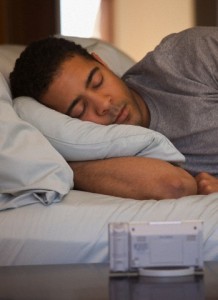(ThyBlackMan.com) When it comes to getting a good night’s sleep, there’s no question – the type of mattress you’re trying to get that good night’s sleep on does matter. But with so many choices, from traditional coil to air, and latex/memory foam, buying the one you need for the healthiest sleep can be a nightmare.
Experts say that neither bells and whistles nor a super-expensive price tag necessarily mean one mattress is better than another. The most important detail is whether or not the mattress is firm enough to provide support to your back, neck, and legs, while still offering some cushion and recoil for comfort.
“You want a mattress that is firm enough to distribute your weight or you’ll wake up sore due to your shoulders sagging or your hips sinking,” says Charles Cefalu, MD, chief of geriatric medicine at Louisiana State University in New Orleans. “On the other hand, you don’t want to sleep on a board,” he says.
Tips for Mattress Shopping
Roger Herr, PT, a Seattle-based spokesman for the American Physical Therapy Association, recommends a mattress that allows you to relax but that also supports the normal S curve of the back.
Experts agree that you have to devote time (about 15 to 20 minutes per mattress) actually testing various sleep surfaces before making a decision. Don’t be shy: Lie on your back, your belly, your side. If you have a  significant other, he or she should be along for the trip.
significant other, he or she should be along for the trip.
Clete A. Kushida, MD, PhD, director of the Stanford Center for Human Sleep Research in Stanford, Calif., and a spokesman for the American Association of Sleep Medicine, suggests this test: “Lie on your side. If your shoulders and hips are sinking, if you feel your spine is not aligned, it’s probably too soft. If you feel pain and discomfort, it’s probably too firm,” he says.
Herr recommends shopping as late in the day as possible. In the morning, when you’re perky, “a lot of things feel good that wouldn’t later,” he says. Even then, buy your mattress from a store with a 30-day refund policy. “That way you have time to really give it a chance.”
Coil
Coil mattresses still offer maximum comfort for many people, depending on their personal preference. One factor to consider is the density of the coils: In general, the more coils per mattress, the smaller they are and the more flexible and
adjustable the mattress, Herr says. He recommends 680 or more coils per mattress. However, heavier people might want larger coils because they are stronger.
“Larger coils are found in the 400s per mattress. They are more durable and preferred for heavier-weighted bodies,” Herr says.
Foam
Herr says that while some people may find that mattresses made from memory or latex foam are more comfortable, they’re not necessarily better for your health. The materials react to body heat and pressure, allowing them to mold to the body within minutes.
“It’s a good marketing tool and may be comfortable for some people that don’t move around much. But if you want to roll around, which can be good for your skin and body, what’s the point of a material that remembers your position? You have to make sure it’s accommodating to all your sleep positions,” he says.
On the other hand, people with joint sensitivity due to arthritis or other conditions may benefit from a mattress that adapts to the body contour, Herr says.
“People who tend to sweat should probably avoid latex, as it doesn’t absorb fluids, Herr adds.
Air, Etc.
Popular hign-end air mattresses like rely on inflatable air chambers to provide support. The dual-chamber models
that allow two people to adjust each side of the bed to their own preferences can be a bonus if one partner likes a firmer mattress while the other prefers a softer one, Kushida says.
Herr says that the smaller the chamber size, the more flexible the surface. “Larger-sized chambers would decrease the adaptability of the surface,” he says.
Many experts add that they also like pillow-top mattresses, which can add a layer of cushioning to a mattress. The softness of the top lets you to tolerate a firmer mattress.
The Best Mattress for Back Problems
Hilibrand says people with back problems in general should look for a firmer mattress that offers support and allows them to lie straighter.
Adjustable hospital-type beds are not going to help you get a better night’s sleep. In fact, they may hinder you as most people prefer to lie flat, Hilibrand says.
But they can help some people with certain spinal conditions, he adds. Consulting your doctor for advice can help in making a smart decision.
The Bed Frame Matters, Too
The frame does matter, Herr says. “Some of the new mattresses have different heights, so when you stack them on top of a box spring, maybe adding a pillow-top as well, it can be hard for people who are older or who have balance problems to get in and out of bed,” he explains.
The solution may be a sunken frame, Herr says, adding that your goal should be an 18-inch span between the floor and the top of the mattress.
Also, periodically check your frame to ensure there is adequate support at the edges and in the middle, he says. Slats often bow in the middle, he notes.
Extending the Life of Your Mattress
If you take care of your mattress, rotating and flipping every six months or according to the manufacturer’s instructions (foam and pillow-top mattresses generally just need rotating, no flipping), it should last at least a decade, the experts say.
If your old mattress starts to sag with age and you can’t afford a new mattress, consider putting a piece of plywood between the mattress and box spring for extra support, Cefalu says.
If you feel like springs are coming through a worn mattress and poking you in your sleep, soft foam egg crate mattress pads are an inexpensive way to extend the life span of your mattress, Hilibrand says.
Written By Lorraine Jones




















Leave a Reply